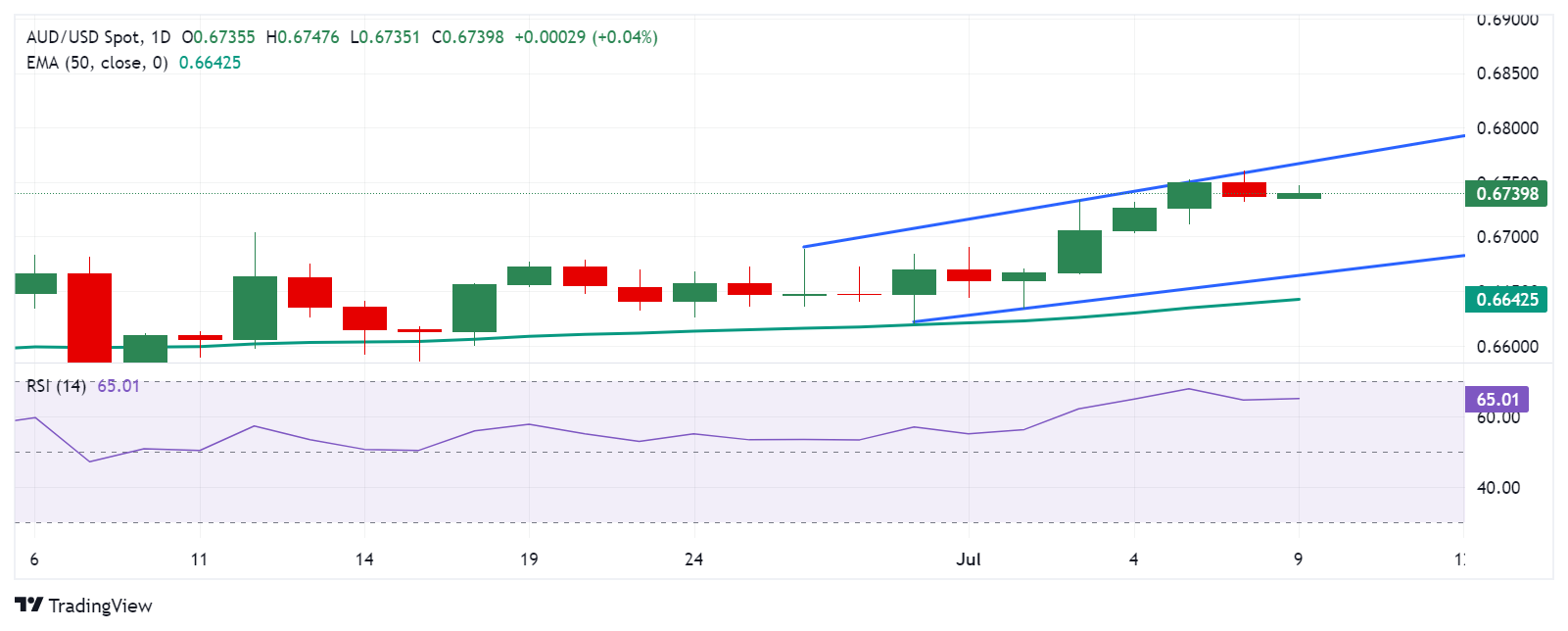- The Australian dollar is gaining ground on expectations that the RBA could delay the global rate cut cycle.
- Australia’s 10-year government bond yield climbs to around 4.4% as foreign investors seek protection from political uncertainties.
- Fed Chairman Powell is scheduled to deliver his “Semi-Annual Monetary Policy Report” to the U.S. Congress on Tuesday.
The Australian Dollar (AUD) is recovering its recent losses, trading near its six-month high of 0.6761 on Tuesday. This rise in the AUD is attributed to growing expectations that the Reserve Bank of Australia (RBA) could delay the global rate-cutting cycle or potentially raise interest rates again due to strong inflation data for May.
Australia’s 10-year government bond yield held steady around 4.4% as high yields attract foreign capital from investors seeking protection from political uncertainties in the US and Europe. Minutes from the RBA’s June meeting highlighted policymakers’ emphasis on the need to remain vigilant regarding inflation risks. They noted that a significant rise in prices could require substantially higher interest rates.
The AUD/USD pair is gaining ground as the US Dollar (USD) struggles on the back of weak US jobs data, leading traders to speculate that the Federal Reserve (Fed) could cut interest rates sooner rather than later. The CME’s FedWatch tool indicates that rate markets are pricing in a 76.2% chance of a rate cut in September, up from 65.5% just a week ago.
Daily Market Wrap: Australian Dollar Gains on RBA’s Bold Side
- Westpac consumer confidence in Australia fell 1.1% in July, reversing the 1.7% rise seen in June. This marks the fifth decline in 2024, driven by continued concerns about high inflation, elevated interest rates and a sluggish economy.
- US Nonfarm Payrolls (NFP) rose by 206,000 in June, following a rise of 218,000 in May. This figure exceeded the market expectation of 190,000.
- The US unemployment rate rose to 4.1% in June from 4.0% in May. Meanwhile, average hourly earnings declined to 3.9% year-over-year in June from the previous reading of 4.1%, in line with market expectations.
- According to the Australian Bureau of Statistics on Thursday, Australia’s trade surplus for May was A$5.773 billion ($3.868 billion), lower than the A$6.678 billion expected and below the previous reading of A$6.548 billion.
- Australia’s retail sales, a measure of consumer spending in the country, rose 0.6% month-on-month in May, up from a 0.1% increase in the previous month. This figure beat market expectations for a 0.2% rise.
- Federal Reserve Bank of Chicago President Austan Goolsbee said on BBC Radio on Wednesday that getting inflation back to 2% will take time and that more economic data is needed. However, on Tuesday, Fed Chair Jerome Powell said the central bank is returning to a disinflationary path, according to Reuters.
Technical Analysis: Australian Dollar Holds Around 0.6750
The Australian dollar is trading around 0.6740 on Tuesday. The daily chart analysis shows that the AUD/USD pair is consolidating within an ascending channel, which indicates a bullish bias. Moreover, the 14-day Relative Strength Index (RSI) is holding above the 50 level, confirming the bullish momentum.
The AUD/USD pair could test the upper boundary of the ascending channel around 0.6765. A break above this level could lead the pair to explore the region around the psychological level of 0.6800.
On the downside, the AUD/USD pair could navigate around the lower boundary of the ascending channel at 0.6665, with added support around the 50-day exponential moving average (EMA) at 0.6642.
AUD/USD: Daily Chart
Australian Dollar PRICE Today
The table below shows the Australian Dollar (AUD) exchange rate against major currencies today. The Australian Dollar was the strongest currency against the Japanese Yen.
| USD | EUR | GBP | JPY | CAD | AUD | NZD | CHF | |
|---|---|---|---|---|---|---|---|---|
| USD | -0.02% | 0.02% | 0.08% | -0.00% | -0.07% | -0.02% | 0.07% | |
| EUR | 0.02% | 0.03% | 0.10% | 0.00% | -0.05% | 0.00% | 0.09% | |
| GBP | -0.02% | -0.03% | 0.06% | -0.02% | -0.06% | -0.03% | 0.05% | |
| JPY | -0.08% | -0.10% | -0.06% | -0.09% | -0.16% | -0.12% | -0.03% | |
| CAD | 0.00% | -0.00% | 0.02% | 0.09% | -0.08% | 0.00% | 0.06% | |
| AUD | 0.07% | 0.05% | 0.06% | 0.16% | 0.08% | 0.04% | 0.10% | |
| NZD | 0.02% | -0.01% | 0.03% | 0.12% | -0.00% | -0.04% | 0.08% | |
| CHF | -0.07% | -0.09% | -0.05% | 0.03% | -0.06% | -0.10% | -0.08% |
The heatmap shows percentage changes of major currencies. The base currency is selected from the left column, while the quote currency is selected from the top row. For example, if you choose the Australian Dollar from the left column and move along the horizontal line to the US Dollar, the percentage change shown in the chart will represent the AUD (base)/USD (quote).
The RBA FAQs
The Reserve Bank of Australia (RBA) sets interest rates and manages Australia’s monetary policy. Decisions are made by a Board of Governors at 11 meetings per year and at ad hoc emergency meetings as necessary. The RBA’s primary mandate is to maintain price stability, which means an inflation rate of 2%-3%, but also to “…contribute to currency stability, full employment and the economic prosperity and well-being of the Australian people.” Its main tool for achieving this is to raise or lower interest rates. Relatively high interest rates will strengthen the Australian Dollar (AUD) and vice versa. Other tools of the RBA are quantitative easing and monetary tightening.
Although inflation has traditionally always been considered a negative factor for currencies, as it reduces the value of money in general, the opposite has actually occurred in modern times with the relaxation of cross-border capital controls. Moderately high inflation now tends to lead central banks to raise their interest rates, which in turn has the effect of attracting more capital inflows from global investors looking for a lucrative place to store their money. This increases the demand for the local currency, which in Australia’s case is the Australian dollar.
Macroeconomic data gauges the health of an economy and can impact the value of its currency. Investors prefer to invest their capital in safe, growing economies rather than in weak, shrinking ones. Greater capital inflows boost aggregate demand and the value of the domestic currency. Classic indicators such as GDP, manufacturing and services PMIs, employment and consumer sentiment surveys can influence the AUD. A strong economy may encourage the Reserve Bank of Australia to raise interest rates, also supporting the AUD.
Quantitative Easing (QE) is a tool used in extreme situations where lowering interest rates is not enough to restore the flow of credit in the economy. QE is the process by which the Reserve Bank of Australia (RBA) prints Australian Dollars (AUD) in order to purchase assets – usually government or corporate bonds – from financial institutions, thereby providing them with much-needed liquidity. QE usually results in a weaker AUD.
Quantitative tightening (QT) is the reverse of QE. It is carried out after QE, when the economic recovery is underway and inflation is starting to rise. While in QE the Reserve Bank of Australia (RBA) buys government and corporate bonds from financial institutions to provide them with liquidity, in QT the RBA stops buying more assets and stops reinvesting the maturing principal of the bonds it already owns. This would be positive (or bullish) for the Australian dollar.
Source: Fx Street
I am Joshua Winder, a senior-level journalist and editor at World Stock Market. I specialize in covering news related to the stock market and economic trends. With more than 8 years of experience in this field, I have become an expert in financial reporting.








